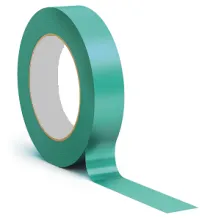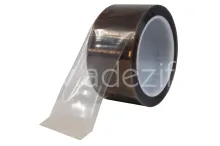High temperature adhesive tape: how to choose it ?
- Single-sided adhesive tape for temperatures above 150°C
- For high temperature applications
- Polyester, glass cloth, Kapton, aluminium, 3M VHB...
Quote
Close
You request has been sent.
We promise to respond to you in detail within 24 hours.
In the meantime, feel free to browse our other products.
Backing and adhesive mass of high temp adhesive tapes
When faced with a bonding problem in a high temperature application, the question always arises: which high temp tape should I choose ? What are the different possible backing materials? Which reference should I use?
This page will help you understand the advantages of each material and its resistance in a hot environment.
First of all, what does "high temperature" means? Generally, it referes to a product that resists temperatures from 150 °C.
Adhesive masses are of great importance for the choice of the adhesive tape and for the heat resistance:
- Thermosetting rubber: up to 130°C
- Acrylic: from -40°C to 150°C
- Silicone: from -60°C to 316°C
The possible backing materials are: polyester, glass cloth, Teflon PTFE, Kapton polyimide, aluminium, masking paper, canvas.
Another possible alternative is the choice of a 100 % acrylic adhesive foam with closed cells from the 3M (VHB tape), ADEZIF or TESA: some references have the particularity to resist efficiently to heat.
What are the temperature classes for insulating media?
For most heat resistant adhesive tapes, their heat resistance is defined by the continous temperature and the peak temperature they are able to withstand.
For thermally insulating materials such as glass cloth and Kapton, which are used in the electrical and electronic industry, 5 temperature classes have been standardized for the continuous operation of electrical equipment.The thermal stability of insulating materials and insulation systems is then guaranteed up to the maximum temperature indicated by class. Their dielectric characteristics are then maintained.
Here is a summary table of the different thermal classes for insulating materials:
| CLASS TYPE | THERMAL STABILITY OF THE INSULATION GUARANTEED UNTIL: | |
|---|---|---|
| Continuous temperature | Peak temperature | |
| Y | 80°C | 105°C |
| A | 105°C | 130°C |
| B | 130°C | 155°C |
| F | 155°C | 175°C |
| H | 180°C | 255°C |
Common high temperature applications
- Masking of epoxy powder coated parts that require a curing cycle or oven drying
- Protection of parts subjected to high temperatures, such as in car engines or exhaust pipesheat resistant
- Holding or shrinking of coils
- Reflection of heat
- Protection of electronic or electrical components
- Protection of flashlight nozzles
- Welding backsides
Technical data of heat resistant tapes
Here is a table with a description, advantages and temperature resistance of some high temp adhesive tapes:
| TAPE BACKING TYPES | DESCRIPTION | ADVANTAGES | REFERENCES | TEMPERATURE RESISTANCE | |
|---|---|---|---|---|---|
| CONTINUOUS | PEAK | ||||
| Polyester | For all applications requiring low thickness, temperature and tensile strength. For high temperature masking with epoxy powder paint or silicon paper connection. | - Small thickness - High tensile strength - Resistant to solvents and chemicals - Can be removed without leaving any traces | Adezif PT891 | 130°C | 200°C |
| Adezif PT821 | 130°C | 150°C | |||
| Adezif PT892 | 130°C | 200°C | |||
| Tesa 50600 | 220°C | ||||
| 3M 8902 | 177°C | 218°C | |||
| 3M 850 | 175°C | ||||
| Glass cloth | For all applications requiring temperature, tensile, wear and fire resistance. Provides thermally stable insulation. Glass fabric backing which can also be aluminized or teflon coated. For high temperature masking, holding or shrinking of coils... | - Unsurpassed tensile strength - Tear and abrasion resistance - Non-flame propagating - Conformable | 3M 398 FR | 121°C | |
| Adezif TV569 | 180°C | 200°C | |||
| 3M 361 | 232°C | 280°C | |||
| 3M 79 | 155°C | 200°C | |||
| 3M 363 (with aluminium) | 316°C | ||||
| Adezif MPTISS13 (with teflon) | 205°C | 260°C | |||
| 3M 5451-5453 (with teflon) | 204°C | 260°C | |||
| Teflon PTFE | For all applications requiring temperature resistance and non-stick properties | - Small thickness - Conformable - Low friction coefficient | Adezif W205 | 205°C | 260°C |
| 3M 5490-5491 | 205°C | 260°C | |||
| Kapton Polyimide | For all applications requiring a thin substrate, mechanical resistance, fire resistance and extreme temperatures. For electrical and electronic protection and insulation | - Thin substrate with excellent mechanical strength - Remains flexible and stable even at high temperatures - Flame retardant - Anti-static property | Adezif KA82 | 180°C | 250°C |
| 3M 92 | 180°C | 265°C | |||
| 3M 5419 | 260°C | ||||
| Aluminium | For all applications requiring thermal conduction, heat protection, flame and chemical resistance | - Fireproof M1 classification - Conformable - Hand tearable - Thermal conductor - Chemical resistant | 3M 433 | 316°C | |
| 3M 425 | 150°C | ||||
| Adezif AL256 (avec tissu de verre) | 160°C | ||||
| Masking paper | For all high-temperature paint masking operations, before the baking cycle | - Temperature resistance - Tearable - Trace-free removal - Economical | 3M 501E | 160°C | |
| Adezif PA400 | 120°C | ||||
| Adezif 4330 | 150°C | ||||
| VHB tape | For all powder coating applications where an oven baking is required | - For a final high performance assembly - Absorption of all mechanical tensions and thermal expansions | 3M 4611 | 150°C | 230°C |
GPH 060 GPH 110 GPH 160 | 150°C | 230°C | |||
| 3M 9460 | 150°C | 260°C | |||
| Acrylic adhesive foam | For epoxy powder coated parts | - For an extremely strong connection - Uniform tension distribution and absorption of thermal expansion | Adezif M708 | 120°C | 150°C |
| TESA ACX+ 7078 | 120°C | 220°C | |||
| Cloth adhesive tape | For masking when applying powder paint | - Exceptional adhesive power thanks to its thermosetting adhesive - Can be removed without leaving traces on most surfaces | TESA 4657 | 100°C | 180°C |














